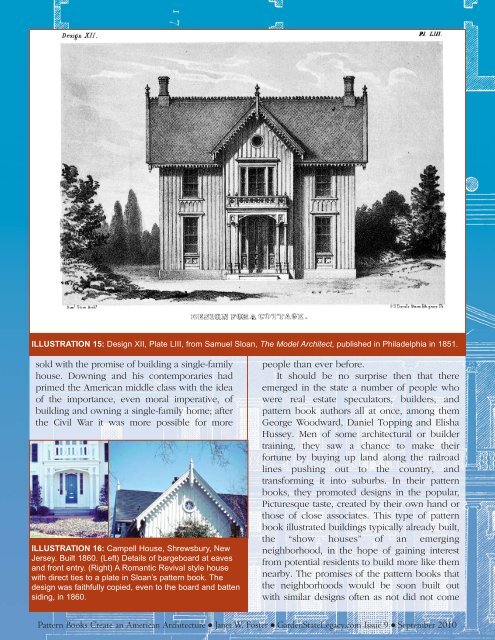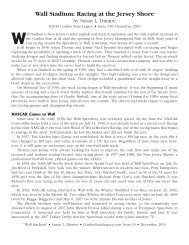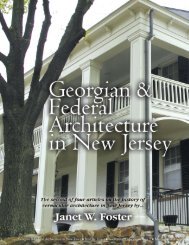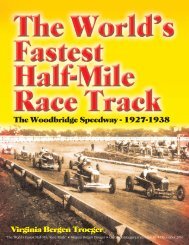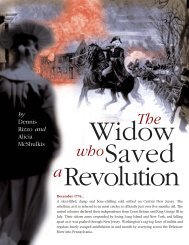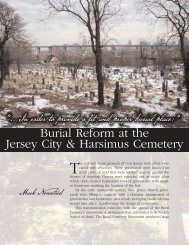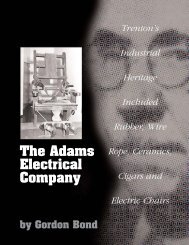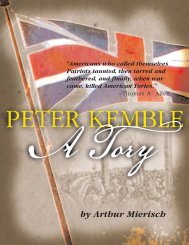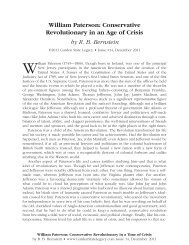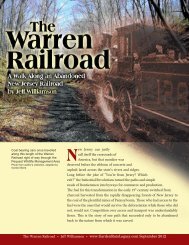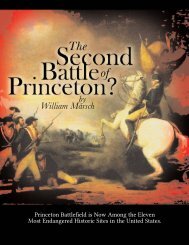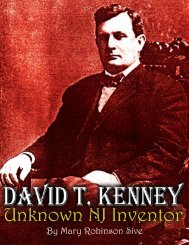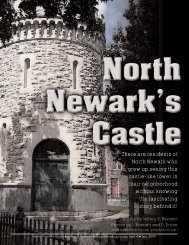Pattern Books Create an American Architecture - Garden State Legacy
Pattern Books Create an American Architecture - Garden State Legacy
Pattern Books Create an American Architecture - Garden State Legacy
Create successful ePaper yourself
Turn your PDF publications into a flip-book with our unique Google optimized e-Paper software.
ILLUSTRATION 15: Design XII, Plate LIII, from Samuel Slo<strong>an</strong>, The Model Architect, published in Philadelphia in 1851.<br />
sold with the promise of building a single-family<br />
house. Downing <strong>an</strong>d his contemporaries had<br />
primed the Americ<strong>an</strong> middle class with the idea<br />
of the import<strong>an</strong>ce, even moral imperative, of<br />
building <strong>an</strong>d owning a single-family home; after<br />
the Civil War it was more possible for more<br />
ILLUSTRATION 16: Campell House, Shrewsbury, New<br />
Jersey. Built 1860. (Left) Details of bargeboard at eaves<br />
<strong>an</strong>d front entry. (Right) A Rom<strong>an</strong>tic Revival style house<br />
with direct ties to a plate in Slo<strong>an</strong>’s pattern book. The<br />
design was faithfully copied, even to the board <strong>an</strong>d batten<br />
siding, in 1860.<br />
people th<strong>an</strong> ever before.<br />
It should be no surprise then that there<br />
emerged in the state a number of people who<br />
were real estate speculators, builders, <strong>an</strong>d<br />
pattern book authors all at once, among them<br />
George Woodward, D<strong>an</strong>iel Topping <strong>an</strong>d Elisha<br />
Hussey. Men of some architectural or builder<br />
training, they saw a ch<strong>an</strong>ce to make their<br />
fortune by buying up l<strong>an</strong>d along the railroad<br />
lines pushing out to the country, <strong>an</strong>d<br />
tr<strong>an</strong>sforming it into suburbs. In their pattern<br />
books, they promoted designs in the popular,<br />
Picturesque taste, created by their own h<strong>an</strong>d or<br />
those of close associates. This type of pattern<br />
book illustrated buildings typically already built,<br />
the “show houses” of <strong>an</strong> emerging<br />
neighborhood, in the hope of gaining interest<br />
from potential residents to build more like them<br />
nearby. The promises of the pattern books that<br />
the neighborhoods would be soon built out<br />
with similar designs often as not did not come<br />
<strong>Pattern</strong> <strong>Books</strong> <strong>Create</strong> <strong>an</strong> Americ<strong>an</strong> <strong>Architecture</strong> J<strong>an</strong>et W. Foster <strong>Garden</strong><strong>State</strong><strong>Legacy</strong>.com Issue 9 September 2010


